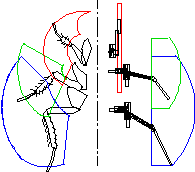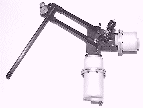Boadicea - Leg Design
Leg design is critical for determining a robot's mobility. Boadicea's
legs were designed to address problems that hampered previous
robots.
The advantages of Boadicea's leg design are:
- a large workspace
- linear foot motions
- a relatively small and compact mechanism
- lightweight construction
The design of Boadicea's legs was inspired by studies of real insects.
The legs use a pantograph mechanism
to produce a large workspace with linear foot motions.
Boadicea's legs are modeled after the cockroach Blaberus Discoidalis
(See picture below), and differ from previous designs in two important
ways:
|
Boadicea's legs have long, overlapping workspaces, allowing the robot to maintain stability when one leg is damaged. Long workspaces also increase speed by extending the stride length.
This picture shows the workspace of the cockroach on the left and Boadicea's workspace on the right.
| 
Workspace of Blaberus Discoidalis and Boadicea
|
Like an insect, Boadicea has different front, middle, and rear
legs. Optimizing each leg design for the role it plays in locomotion
improves the robot's performance.
|
Boadicea's legs use a 2 dimensional pantograph mechanism. Several walking robots incorporate this mechanism because it produces linear foot motions, simplifying software requirements [Hirose 84].
|

|
A second advantage of the pantograph is that it provides a large
leg workspace with a relatively simple and compact mechanism.
Boadicea's legs have a greater range of motion than other walking
robots. Attila, Genghis, the Adaptive Suspension Vehicle, the
OSU Hexapod, and other robots have all had a maximum step length
about one third of the total body length [Angle 89] [Angle
91] [Waldron, et al 84] [McGhee and Iswandhi 79]. Boadicea's
rear legs have a maximum step length nearly 70% of the total body
length.
Because Boadicea is a much smaller and lighter robot, the pantographs
can be much simpler than that used on other robots. Boadicea's
pantographs are made from injection molded plastic, and use low-friction
sliding prismatic joints. Pantographs on other robots must support
large loads, requiring metal construction and complex bearing
components [Waldron, et al 84].
 This page is still under construction.
This page is still under construction.
[Boadicea top page]
[Fluid Power] [Materials & Construction]
[Biological Inspirations]
[Leg Design] [Sensors & Electronics]
[Control System]
[Results] [Conclusions]
[Photos & Video] [Papers] [Related
Web sites]


 This page is still under construction.
This page is still under construction.